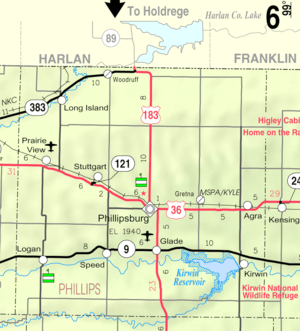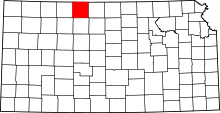Logan, Kansas
| Logan, Kansas | |
|---|---|
| City | |
 Location within Phillips County and Kansas | |
 KDOT map of Phillips County (legend) | |
| Coordinates: 39°39′44″N 99°34′16″W / 39.66222°N 99.57111°WCoordinates: 39°39′44″N 99°34′16″W / 39.66222°N 99.57111°W | |
| Country | United States |
| State | Kansas |
| County | Phillips |
| Area[1] | |
| • Total | 1.51 sq mi (3.91 km2) |
| • Land | 1.51 sq mi (3.91 km2) |
| • Water | 0 sq mi (0 km2) |
| Elevation | 1,975 ft (602 m) |
| Population (2010)[2] | |
| • Total | 589 |
| • Estimate (2015)[3] | 554 |
| • Density | 390/sq mi (150/km2) |
| Time zone | Central (CST) (UTC-6) |
| • Summer (DST) | CDT (UTC-5) |
| ZIP code | 67646 |
| Area code(s) | 785 |
| FIPS code | 20-42100 [4] |
| GNIS feature ID | 0472023 [5] |
| Website | City Website |
Logan is a city in Phillips County, Kansas, United States. As of the 2010 census, the city population was 589.[6]
History
Logan was founded in 1870.[7] It was named for Gen. John A. Logan.[8] The first post office in Logan was established in March 1872.[9]
Logan experienced growth when, circa 1880, the railroad was built through the town.[10]
Geography
Logan is located at 39°39′44″N 99°34′16″W / 39.66222°N 99.57111°W (39.662269, -99.571160).[11] According to the United States Census Bureau, the city has a total area of 1.51 square miles (3.91 km2), all land.[1]
Demographics
| Historical population | |||
|---|---|---|---|
| Census | Pop. | %± | |
| 1880 | 275 | — | |
| 1890 | 390 | 41.8% | |
| 1900 | 449 | 15.1% | |
| 1910 | 714 | 59.0% | |
| 1920 | 585 | −18.1% | |
| 1930 | 743 | 27.0% | |
| 1940 | 703 | −5.4% | |
| 1950 | 859 | 22.2% | |
| 1960 | 846 | −1.5% | |
| 1970 | 760 | −10.2% | |
| 1980 | 720 | −5.3% | |
| 1990 | 633 | −12.1% | |
| 2000 | 603 | −4.7% | |
| 2010 | 589 | −2.3% | |
| Est. 2015 | 554 | [3] | −5.9% |
| U.S. Decennial Census | |||
2010 census
As of the census[2] of 2010, there were 589 people, 261 households, and 169 families residing in the city. The population density was 390.1 inhabitants per square mile (150.6/km2). There were 311 housing units at an average density of 206.0 per square mile (79.5/km2). The racial makeup of the city was 99.3% White, 0.5% from other races, and 0.2% from two or more races. Hispanic or Latino of any race were 1.5% of the population.
There were 261 households of which 24.9% had children under the age of 18 living with them, 53.3% were married couples living together, 6.9% had a female householder with no husband present, 4.6% had a male householder with no wife present, and 35.2% were non-families. 33.7% of all households were made up of individuals and 18.4% had someone living alone who was 65 years of age or older. The average household size was 2.26 and the average family size was 2.85.
The median age in the city was 45.2 years. 27% of residents were under the age of 18; 2.6% were between the ages of 18 and 24; 20.3% were from 25 to 44; 26.9% were from 45 to 64; and 23.3% were 65 years of age or older. The gender makeup of the city was 45.7% male and 54.3% female.
2000 census
As of the census[4] of 2000, there were 603 people, 249 households, and 167 families residing in the city. The population density was 398.8 people per square mile (154.2/km²). There were 304 housing units at an average density of 201.1 per square mile (77.7/km²). The racial makeup of the city was 99.34% White, 0.17% African American, and 0.50% from two or more races.
There were 249 households out of which 26.1% had children under the age of 18 living with them, 56.2% were married couples living together, 7.6% had a female householder with no husband present, and 32.9% were non-families. 30.5% of all households were made up of individuals and 16.1% had someone living alone who was 65 years of age or older. The average household size was 2.22 and the average family size was 2.78.
In the city the population was spread out with 21.7% under the age of 18, 4.6% from 18 to 24, 20.6% from 25 to 44, 25.4% from 45 to 64, and 27.7% who were 65 years of age or older. The median age was 47 years. For every 100 females there were 78.4 males. For every 100 females age 18 and over, there were 76.1 males.
The median income for a household in the city was $29,417, and the median income for a family was $35,769. Males had a median income of $28,393 versus $20,000 for females. The per capita income for the city was $14,336. About 8.3% of families and 12.4% of the population were below the poverty line, including 17.3% of those under age 18 and 9.9% of those age 65 or over.
References
- 1 2 "US Gazetteer files 2010". United States Census Bureau. Retrieved 2012-07-06.
- 1 2 "American FactFinder". United States Census Bureau. Retrieved 2012-07-06.
- 1 2 "Annual Estimates of the Resident Population for Incorporated Places: April 1, 2010 to July 1, 2015". Retrieved July 2, 2016.
- 1 2 "American FactFinder". United States Census Bureau. Retrieved 2008-01-31.
- ↑ "US Board on Geographic Names". United States Geological Survey. 2007-10-25. Retrieved 2008-01-31.
- ↑ "2010 City Population and Housing Occupancy Status". U.S. Census Bureau. Retrieved September 18, 2011.
- ↑ Kansas State Historical Society (1916). Biennial Report of the Board of Directors of the Kansas State Historical Society. Kansas State Printing Plant. p. 261.
- ↑ "Profile for Logan, Kansas". ePodunk. Retrieved 22 June 2014.
- ↑ "Kansas Post Offices, 1828-1961". Kansas Historical Society. Archived from the original on October 9, 2013. Retrieved 22 June 2014.
- ↑ Blackmar, Frank Wilson (1912). Kansas: A Cyclopedia of State History, Volume 2. Standard Publishing Company. p. 180.
- ↑ "US Gazetteer files: 2010, 2000, and 1990". United States Census Bureau. 2011-02-12. Retrieved 2011-04-23.
External links
| Wikimedia Commons has media related to Logan, Kansas. |
- City
- Schools
- USD 326, local school district
- Maps
- Logan City Map, KDOT
